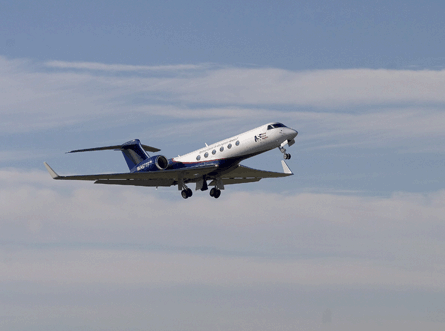Hiaper, a modified Gulfstream V and one of the USA's most advanced research aircraft, is embarking on a three-year mission spanning the globe from the Arctic to the Antarctic in a bid to generate the most detailed carbon dioxide readings ever recorded.
Starting this month, the Hiaper Pole-to-Pole Observations (HIPPO) mission will cover more than 38,650km (20,900nm) as an international team of scientists makes a series of five historic flights over the next three years sampling the atmosphere in some of the world's most inaccessible regions.
The goal of the mission is ambitious: the first-ever, global, real-time sampling of CO2 and other greenhouse gasses across a wide range of altitudes in the atmosphere, literally from pole to pole.
 |
|---|
The aircraft will gather data from various altitudes over mountains, plains and large cities, and will use them to put together a comprehensive picture of the amounts of carbon that are emitted into the atmosphere yearly, as well as of the quantities that are absorbed by trees, vegetation and oceans in the same timeframe.
To date, much of our understanding of global atmospheric greenhouse gasses has been acquired from distant satellites, balloon launches or supercomputer models.
Hiaper's pole-to-pole mission will, for the first time, give scientists real-time global observation data to correlate with those climate models.
Hiaper - the National Science Foundation's High-performance Instrumented Airborne Platform for Environmental Research - can fly at high altitudes for extended periods and can carry 2,540kg (5,600lb) of sensing equipment.
Led by Harvard University, HIPPO's other partners include the National Science Foundation, the National Center for Atmospheric Research, the National Oceanic and Atmospheric Administration and the Scripps Institution of Oceanography.
The main goal of this ambitious project is to amend and improve existing weather pattern changing models, and to come up with accurate new predictions for the future, which could mould climate change policy makers.
In a video posted on the National Science Foundation website, Cambridge professor of atmospheric and environmental science Steven Wofsy says that "when we finish up, we'll have a completely new picture about how greenhouse gases are entering the atmosphere and being removed from the atmosphere both by natural processes and by humans".
He adds: "It's the first time we've been able to look at the whole globe all at once. Nobody has ever done that. Satellites see the whole globe, but they don't see it in great detail," he adds.
Click to view the video and animation of the HIPPO mission
Source: Flight International




















